Michigan
Does Michigan have sanctuary cities? Here’s where and what it means

White House: Migrants bused, flown north is a ‘political stunt’
GOP governors are taking credit for busing and flying migrants and asylum seekers north in order to spotlight various immigration issues.
Scott L. Hall, USA TODAY
Immigration reform and border enforcement are once again big talking points heading into the presidential election. And the debate on immigration issues isn’t a new conversation.
In the last decade, immigration has been a hot topic, but in this election cycle, Americans now believe immigration to be the most important issue facing the United States, a Gallup poll released this week revealed. In recent months, Texas Gov. Greg Abbott (R) has been vocal about the border and keeping migrants from crossing over illegally and pushed “Operation Lone Star”— a 2021 initiative by Abbott that sent the Texas National Guard and Texas Department of Public Safety to the southern border to “fill the dangerous gaps created by the Biden Administration’s refusal to secure the border.”
The operation has also bused and flown more than 100,000 migrants from the Texas border to Washington, D.C., New York, Chicago, Denver, Philadelphia, and Los Angeles. All deemed sanctuary cities.
These larger metropolitan areas are just a handful of 100s of communities, and even some states, that have identified themselves as sanctuary areas for migrants in the United States. There are several communities in Michigan as well that have identified themselves as sanctuary areas as well.
What is a sanctuary city?
Sanctuary city is a common term now, but a sanctuary area can be classified as a city, county, or state in America that doesn’t fully comply with federal immigration enforcement efforts. Usually, this is done through municipal laws that protect undocumented immigrants from deportation or prosecution, despite federal immigration law.
Practices and laws that are in place allow agencies to refuse, or prohibit, compliance with ICE detainers and impose unreasonable conditions on detainer acceptance. Some also deny ICE access to interview incarcerated aliens and stop immigration enforcement from impeding communication or information exchanges between their personnel and federal immigration officers, according to the Center for Immigration Studies.
Is Michigan a sanctuary state?
No, Michigan is not a sanctuary state, but it does have a city and several counties that are designated as sanctuary areas, according to the Center for Immigration Studies.
What are Michigan’s sanctuary cities and counties?
- Lansing: Is the only city in Michigan that is a sanctuary city.
- Ingham County
- Kalamazoo County
- Kent County
- Wayne County
Detroit and Ann Arbor are often referred to as sanctuary cities, though they haven’t officially declared themselves as such. Detroit has multiple times proclaimed itself a “Welcoming City,” according to City Council’s Legislative Policy Division. Both cities have policies in place that limit cooperation with federal immigration authorities and generally bar police from inquiring about individuals’ immigration status or engaging in profiling based on ethnicity or religion.
Migrants in Michigan
While Michigan may not be getting an influx of migrants shipped from Texas, the communities in the state are no strangers to people looking to start their lives in the U.S. here.
In 2016, Michigan was the fourth largest state for refugee resettlement, taking in more than 30,000 arrivals over the previous decade, Global Detroit reported.
Undocumented immigrants accounted for 1.2% of Michigan’s population as of 2021, per Pew Research Center analysis.

Michigan
BREAKING: Spartans Secure 5th 2025 Commit RB Jace Clarizio

Michigan State coach Jonathan Smith is on a roll. The Spartans secured their fifth commit from the 2025 class in East Lansing running back Jace Clarizio.
Clarizio is a three-star recruit, per 247Sports. The hometown prospect is the No. 10 player in the state and the No. 64 running back in the country. Clarizio has an 87 grade from 247Sports.
The site characterizes the grade as “usually has one key trait that signals long-term potential. The floor might be going to be lower than some of the prospects ranked ahead of them, but they have a higher ceiling than the prospects below them.”
Clarizio told 247Sports’ Corey Robinson that he thought he would fit well in offensive coordinator Brian Lindgren’s offense. He also said he liked the coaching staff.
“[Michigan State is] really smart, offensive-minded, I think, and defense, too,” Clarizio told 247Sports. “I feel like they’re just good coaches. They’re smart and they’re gonna put their players in the best position to get the job done … [The Spartans’] system, I feel like it would fit me really well. They like getting the running back the ball out of the backfield, and I think that fits me. Just their style.”
Clarizio was scheduled to visit Michigan State on June 14.
National recruiting analyst Allen Trieu evaluated Clarizio:
“One cut and go type of runner who shows enough burst and acceleration to get into open field. Shows vision and ability to find running lanes. Looks to have enough top end to run away from defenders on the high school level although there is currently not a reliable verified time on him. Can string plays to the outside and get the corner but can also run between the tackles. Has subtle wiggle and is a twitchy athlete. Above average size … All-around back with no real glaring deficiencies and should be a starter at the high-major level.”
Clarizio is the fifth 2025 commit for Michigan State. He is the third in three days, behind three-star linebacker Di’Mari Malone on Mother’s Day and three-star tight end Emmett Bork on Monday.
Don’t forget to follow the official Spartan Nation Page on Facebook Spartan Nation WHEN YOU CLICK RIGHT HERE, and be a part of our vibrant community group Go Green Go White as well WHEN YOU CLICK RIGHT HERE.
Michigan
Former Longwood, Utah State center Szymon Zapala transfers to Michigan State basketball
Michigan State basketball fans rejoice: Tom Izzo has landed a big man in the transfer portal.
Longwood center Szymon Zapala announced his commitment to Michigan State Tuesday afternoon. Zapala, originally from Poland, played one season at Longwood after spending the first three seasons of his collegiate career at Utah State. He has played four college seasons so far, but appeared in just 13 games as a freshman.
The addition of Zapala adds height to Michigan State’s big men options. The Polish center is listed at 7 feet and 240 pounds, adding size to a frontcourt that includes Carson Cooper, Jaxon Kohler, Xavier Booker and incoming freshman Jesse McCulloch.
As a senior at Longwood, Zapala averaged 9.8 points, 5.6 rebounds and just under a block per game in 35 appearances averaging 16.8 minutes per game. He primarily played inside the arc on offense and shot 62.9% from the field while attempting just three 3s, making two. Zapala was a part of a Longwood team that won the Big South conference tournament to reach the NCAA tournament as a 16-seed before losing to Houston.
Zapala played sparingly for Utah State during his first three seasons, making 45 appearances for the Aggies. He averaged 1.2 points and 1.3 rebounds in 4.6 minutes per game for Utah State.
He enrolled in Utah State as a three-star recruit out of Poland fresh off playing for the national team in the 2019 FIBA U18 European Championships, where he helped Poland finish second while averaging 7.5 points per game. He also played for Trefl Sopot, a Polish professional team, in the U20 Polish Cup and helped lead the team to the championship.
Zapala is Michigan State’s second addition through the transfer portal this offseason. In April, MSU picked up a commitment from wing Frankie Fidler, who averaged 20.1 points per game at Omaha. Michigan State had two players, Mady Sissoko and A.J. Hoggard, enter the transfer portal. Sissoko committed to Cal, while Hoggard is going through workouts for the NBA draft.
Michigan
Literacy, mental health, and at-risk funding: What will lawmakers prioritize in the state school budget?

Sign up for Chalkbeat Detroit’s free daily newsletter to keep up with the city’s public school system and Michigan education policy
Michigan lawmakers are poised to approve a state education budget that would build on last year’s historic investment in the state’s most vulnerable students, while also increasing funding to improve student mental health, education for English language learners, and literacy.
But some students, parents, educators, and advocates are worried that the state won’t be able to fully fund “dire” needs at a time when Michigan faces several budgetary challenges.
Roughly $5.6 billion in federal COVID relief funds will expire this year, and state revenue growth is expected to slow in coming years. Declining enrollment also has created funding shortfalls in some districts.
Some fear districts will face painful cuts.
“The state of education right now is – truly, we’re desperate,” said Kathi Martin, a speech language pathologist and union president in Dearborn Public Schools.
“The amount of resources we have never seems to be enough,” she added.
Last week, the House passed a proposed budget that would increase school funding by $900 million compared to last year’s. That’s just slightly higher than what Whitmer proposed in her executive budget.
The Senate appropriations committee has also proposed an increase in school aid, of $1.1 billion. The Senate has not yet voted on the committee’s recommended budget, however, and is expected to take a vote in the coming days.
The legislature has a deadline of July 1 to pass a state budget. When both houses pass a budget, it will go to the governor to sign. It will take effect Oct. 1.
Last year, lawmakers passed a $21.5 billion school budget that included historic increases to benefit the state’s neediest students. But advocates say legislators must keep up the momentum to continue to work toward more equitably funding Michigan schools.
Here’s what lawmakers have proposed:
Increases to the “opportunity index”
For years, Michigan has been ranked among the worst states in the nation for the inequities in funding between schools in wealthy and poor communities.
Last year, the budget gave an additional $1 billion in funding to districts to serve at-risk students through the “opportunity index,” which provides money to districts serving communities with higher concentrations of poverty.
“Michigan must continue to take bold steps for an equitable education for its students,” said Elnora Gavin, a Benton Harbor School Board member, in a statement.
Here are some of the highlights:
- The Senate committee’s proposal includes a $122.6 million increase to at-risk funds. It would allow districts to use up to 60% of the money to recruit and retain instructional staff as well as staff who help improve students’ social, emotional, or physical health.
- The House proposes a $70.1 million increase. That proposal also includes language that would allow the Detroit Public Schools Community District to use up to 40% of the money to hire more instructional staff or increase teacher salaries.
- The executive proposal would increase at-risk funding by $23.8 million. It would allow some districts to use up to 30% of the money for teacher recruitment and retention.
Advocates have asked lawmakers to increase the opportunity index funds by 20% over the next five years until it eventually equates to around $2.9 billion in additional funding for at-risk students each year.
What legislators are currently recommending for 2024-25 ranges from a 2.5% to around 12.8% increase over last year’s at-risk funding.
More money for mental health
Since 2021, Michigan has invested more than $715 million in student mental health programs and hiring more school counselors. However, advocates and educators say more school counselors, psychologists, and social workers are needed to adequately address students’ needs during an ongoing youth mental health crisis. The state had the third highest ratio of counselors to students in the country, according to the most recently available data.
“A lot of students’ grades are low because they are facing mental health problems and are not being heard by our teachers,” said Christina Yarn, a 17-year-old attending Saginaw Community Schools’ Heritage High School.
The governor’s office and the House both propose $300 million in per-pupil funding – $3.3 million more than last year– to improve student mental health and school safety, which is in line with what advocates have asked for. Both proposals have restrictions on the funds to be used for school resource officers. The Senate committee proposes a lower amount, $150 million for the funds, with no restrictions on districts for paying school police.
Small increase for English language learners
The state increased funding for English language learners last year, but still ranked among the worst in the nation for its funding of such programs compared to other states in 2023, according to Ed Trust Midwest.
“We have many immigrant and migrant students attending our schools,” said Martin. “Lots of children come to school and they don’t know English. In order to adequately teach these children, we need more resources than just one teacher in a room with 27 kids.”
The Senate committee’s proposal would double funding for English learners with an increase of $39.7 million.The governor and the House propose much smaller increases – $3 million and $5 million respectively.
One-time funds for literacy
Michigan has long struggled with student literacy rates. It ranks 43rd in the country for fourth grade reading. While more money was allocated to literacy efforts such as reading coaches and early literacy training for teachers last year, some administrators say they are unable to fill open positions.
The governor proposed $155 million in one-time funding to create a Committee for Literacy Development; offer a ranked list of curricula and professional development for teachers; and fund early literacy teacher coaching positions. The House and the Senate committee’s proposals include similar budget items.
Cuts to the teacher retirement fund
In order to pay for proposed increases to big items on the proposed budgets, legislators are considering making cuts to contributions to the state’s retirement funds for public school employees.
The governor wants to fund $758.9 million less than the $2.5 billion the state put into the Michigan Public School Employees’ Retirement System in 2023-24. The House proposes reducing payments to the funds by $562.4 million. The Senate committee recommends $41.3 million in cuts.
Republican lawmakers have voiced concerns that these cuts would add to an existing pension debt in the system.
Democrats, including Whitmer, say that health care is fully funded under the plan and that it is feasible for the state to scale back its investments in helping districts make payments into the plan.
Hannah Dellinger covers K-12 education and state education policy for Chalkbeat Detroit. You can reach her at hdellinger@chalkbeat.org.
-

 Politics1 week ago
Politics1 week agoHouse Dems seeking re-election seemingly reverse course, call on Biden to 'bring order to the southern border'
-

 World1 week ago
World1 week agoSpain and Argentina trade jibes in row before visit by President Milei
-

 Politics1 week ago
Politics1 week agoFetterman says anti-Israel campus protests ‘working against peace' in Middle East, not putting hostages first
-

 World1 week ago
World1 week agoGerman socialist candidate attacked before EU elections
-

 News1 week ago
News1 week agoUS man diagnosed with brain damage after allegedly being pushed into lake
-

 World1 week ago
World1 week agoGaza ceasefire talks at crucial stage as Hamas delegation leaves Cairo
-

 Politics1 week ago
Politics1 week agoRepublicans believe college campus chaos works in their favor
-

 Politics1 week ago
Politics1 week agoConservative beer brand plans 'Frat Boy Summer' event celebrating college students who defended American flag




















